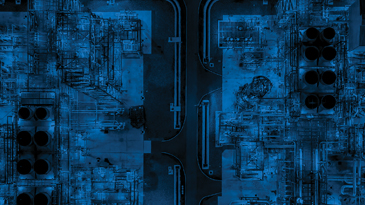Consider this: an offshore drilling rig today has over 1 million times the computing power of Apollo 11, the first manned spaceflight to land on the moon. The airline Virgin Atlantic produces half of a terabyte of data for every hour it flies. We have computing power, we have data, and the possibilities are endless. But how can we use the data we have to outpace our competition?
Companies already know that they have “big data” — huge data sets from ERP, planning, scheduling, production, asset monitoring, maintenance, work order and other systems. The challenge is what to do with it all — and how can you use your existing data to achieve competitive advantage through making better decisions? Developing an asset performance management (APM) strategy that complements and leverages the relevant findings from your reliability-centered maintenance (RCM) program can be challenging. Where do you start?
Adding machine learning to your existing program can increase your uptime and decrease your maintenance costs. Equipment- and process-induced failures can now be predicted earlier than ever — and prevented. What would it mean to your business to have notification of equipment failure 67 days in advance versus three? Maintenance is no longer a cost center; change the game by adding machine learning to predict and mitigate impending failures.
Real-world experience has shown us that failures won’t happen on a date and time of your choosing or estimation. In the age of machine learning, we are going beyond the traditional maintenance best practices of running to failure, calendar-based maintenance, maintenance based on usage or condition of the equipment and reliability-centered maintenance. The gains from RCM combined with APM are exponential with predictive and prescriptive maintenance via machine learning.
APM and RCM programs are not new, but the industry is always looking for areas of new opportunity and growth, improved on-time order fulfillment and increased uptime. Whether you feel your organization is behind in APM or you'd just like to leapfrog past your breakneck competition, consider embracing machine learning. Let’s explore how to get started with machine learning and how to gain actionable insights that generate a quick return on investment — a quick win!
Our top six keys to efficiently creating the most sustainable value with machine learning are:
-
Just do it. While some companies are agonizing over which technology to employ first, others are electing to get started. Start with just one asset or a particular class of assets. A properly scoped project allows you to determine if the project is yielding the intended results.
-
Start small. You don’t have to ask for millions of dollars for a full deployment of new machine learning technology — pick one (software) and then scope the project that will best serve your needs. The software should simplify and automate detection and correction of impending failure and prescribe decisive action. To set up the system appropriately, we would look at the predictive analysis and verify the prescriptive actions with your designated team. Experts in the field will leverage their knowledge, and they won't need a Ph.D.
-
Select the right machine learning software. I know, easier said than done. Look for leading-edge technology with proven results. More on this later.
-
Leverage your in-house talent. We call this tapping into your “tribal knowledge.” Many articles have been written about the number of retirees walking out the door in the next five years, taking their domain expertise with them. Capture this knowledge and include your operators in the project. They know your equipment better than anyone and can work during the implementation with the team to gain insight into your bad actors. Once you are empowered with information, there will still be continual refinement. Your team must be passionate about the vision, and the opportunities brought to bear with machine learning. You’ll have your own subject matter experts (SMEs) at different locations and in your reliability team.
With machine learning, using creative destruction to maximize performance is alive and well. Your team will analyze failure signatures and determine the process and the escalation likely based on the mean-time between failure and the mean-time between maintenance. You can then build “what if” scenarios to determine the best course of action.
-
Reap the benefits. There are many benefits from leveraging software that continues to learn on your equipment. Across the board, we find that most customers appreciate the increased number of on-time orders, increased operational uptime, and reduction of maintenance costs.
-
Be courageous. Take a big data approach to small data first. (See recommendation number 1.) There’s no magic button to execute a successful project. Success is a balance of people, process, and technology. Pick team members for their passion, talents, and willingness to take ownership. As you reach key milestones be sure to recognize the team members for their contribution. You will not only create good will among the team, but you may just leapfrog ahead of your competitors.
If you can take this approach, then all you have left to do is select the right software to meet your needs. I’ll explore that topic in my next blog post (six more helpful hints!), and you can also take a look at our aspenONE® Asset Performance Management solutions to see how our applications of machine learning can help your business eliminate unwanted downtime.






Leave A Comment